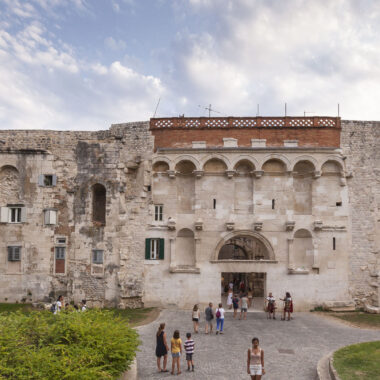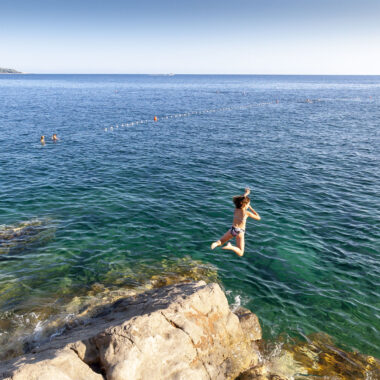The Pelješac Peninsula is a finger of land extending north of Dubrovnik, from the isthmus that begins at Ston to the top of Lovišta. The landmass stretches across the mouth of the Bosnian Bay of Klek and is home to some of the best wineries in Croatia. In particular, the peninsula is known for production of wine from the endemic Croatian varietal Plavac Mali: a hardy, red varietal that is well-suited to the dry limestone terroir of the region. The vines often have root systems that extend more than 20 meters/66 feet into limestone seams in search of water. Everything on Pelješac is dry farmed, and 99.9% of the grapes we saw were bush vines, enabling the plants to naturally protect the berries from the scorching summer Croatian sun. Some serious backbreaking work to farm along Pelješac: everything is hand-picked, hand-pruned and even manually weeded.
Get Directions
Lisa had done some pretty extensive research as to which wineries she wanted to visit in the area, teeing up appointments along Pelješac at a couple of small, family-run outfits for our day of exploring. First stop was at Miloš in the tiny village of Boljenovići, which we reached after driving through an absolutely torrential downpour at the southern end of the peninsula. The winery was run by two brothers but had been in the family for more than 500 years. Pretty amazing to visit an area where winemaking had been part of the culture for multiple centuries, and winemaking techniques that are currently trendy in Western winemaking – native fermentation, biodynamic farming, whole cluster ferments – have been practiced since medieval times. Even though it was the middle of the vintage, one of the brothers spent almost an hour with Lisa and I, tasting us through their unique wines and chatting about the area. The Plavac Mali and Rukatac offerings were excellent, quite special to taste some of their vintage selections, wines that are held back for more than a decade before being released.
We couldn’t drag the kids around to winery after winery all day without a little adventure mixed in, fortunately – as with most coastal areas of Croatia – Pelješac is littered with quaint fishing villages along its coast and we didn’t have too much trouble finding a spot to take a swim between tasting rooms. We took a packed lunch and ventured to sleepy Žuljana on Pelješac’s western coast for a dip and bite after Miloš, Plaža Vučine providing an exceptionally picturesque spot to swim. The beach only had a handful of bathers on it and the snorkeling was great along the rocky edge of the bay. Pretty sure everyone would have been content spending the entire afternoon there if we didn’t have more wineries to visit!
The coast road between Žuljana and Trstenik wound through some incredibly steep vineyards rolling down the limestone soil all the way to the ocean, the photos here really don’t do the pitch of the slopes justice. We made a quick stop in Trstenik at Grgić Vina – the winery owned by the same family as Grgić Hills Estate in Napa – an amazing piece of property overlooking the Adriatic. Lisa wasn’t too excited about the wines at Grgić, especially after tasting some of the elegant offerings from Miloš, but it was worth the stop just to take in the view from the tasting room.
Our last winery of the day was further north along Pelješac in the village of Prizdrina at Vinarija Bartulović. Even though Prizdrina was home to only four families and a total of 20 people, it took us a little hunting to find the winery, which was tucked down a small alleyway underneath the eccentric and gregarious winemaker’s home. Along the way we were a little sidetracked by the winemaker’s three kids, who were trying to fleece Max and Lilia out of 2€ each to try their zip-line (which was a piece of string about six feet long tied between two portions of their makeshift fort).
Maro was an exceptional host, talking us through his family’s and the Pelješac’s history of winemaking. The acreage he farmed on Pelješac had been in his family for 17 generations, and had been planted with vines since 1520. His grandfather smuggled stainless steel from Italy during the communist Yugoslavia era and had to learn how to weld it in order to fabricate Pelješac’s first stainless steel tanks. Maro was a one man show except for some help with harvesting the grapes: winemaker, vineyard manager, tavern owner, farmer, bed and breakfast proprietor and father to three boisterous kids. His Plavac Mali and Rukatac offerings were very approachable, and some of his blends were wonderful as well. To be honest, for the hour of fast-talking entertainment he provided, I think we would have left with a couple of bottles even if the wine was subpar! Amazing to reflect on the fact that even though the vineyards had been in his family for more than 500 years, he is the first in his family to bottle wine from them: historically the wine had been served direct from barrel, and during the communist Yugoslavia era all grapes were required to be sold to the government, which then mass produced wine for the state.
It was also interesting to taste some of hisPlavac Mali from the Dingač appellation, a heavily-regulated and arguably Croatia’s most famous wine growing region on the coast of Pelješac. There are only a handful of families that own vineyard land on Dingač – the Bartulović family is one of them – and the government only allows those families to use theDingač appellation on their products. We visited the vineyards after our time at Vinarija Bartulović, some incredibly steep terroir.
It’s hard to think of a better way to finish a day of wine tasting than with a round of oysters and beer. The eastern side ofPelješac is known for producing some of Croatia’s best oysters so we stopped in Mali Ston on our way back to Dubrovnik for a quick snack. The oyster farms stretched as far as the eye could see along the coast, we settled in at hole-in-the-wall Oyster Bar Bebek and enjoyed some delicious mollusks with a couple of tall Karlovačkos. Very delicate and especially briny, we downed a dozen in short order and went for another after the kids asked for more. We also took a quick walk around the neighboring walled city of Ston, the fortress and moat were very impressive relics of the medieval age.
A really exceptional day, a little bit of something for everyone. The two family-owned wineries we visited –Miloš andBartulović – were such interesting journeys into the history of Pelješac, and we couldn’t have asked for better hosts at either establishment. The beautiful beach at Plaža Vučine and oysters at Mali Ston were icing on the cake. Great to get off the beaten path a little from the hustle and bustle of touristy Dubrovnik.
































































Pingback: Dubrovnik – Our Walkabout Two
Pingback: Vis – Our Walkabout Two
What an ABSOLUTELY WONDERFUL WONDERFUL DAY!!!!!!!!!! We are so happy … for you all!!! With your amazing pallet, Lisa, those two wineries (along with their histories) must have been glorious! And the swims and the oysters PERFECT breaks for everyone. My heart is full … for you all! Love and hugs, Your Family !